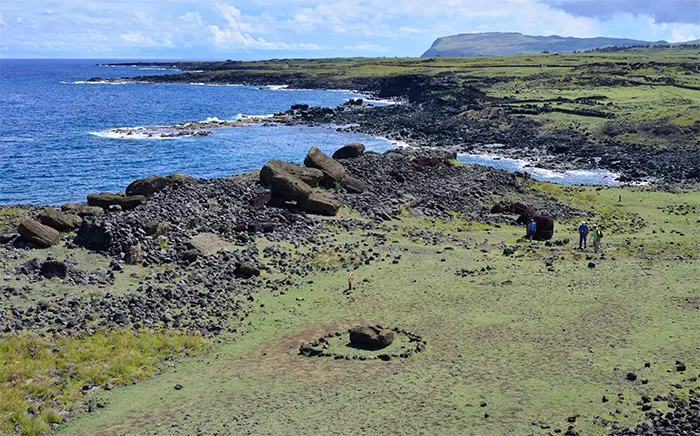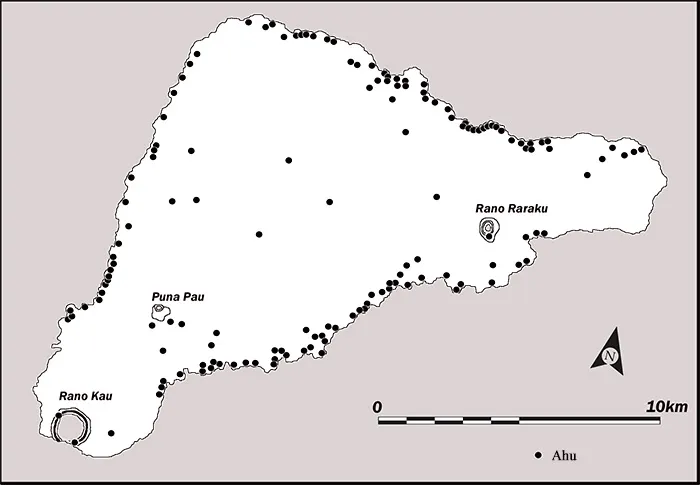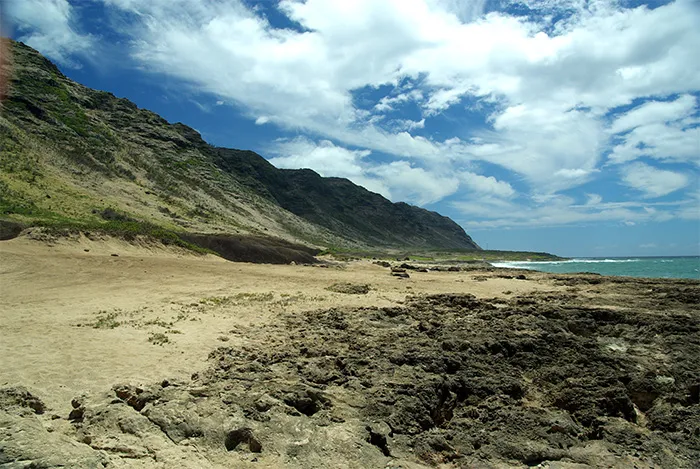The Canoe-Shaped Houses and Monumental Archaeology of Rapa Nui (Easter Island)
Introduction
The archaeology of Rapa Nui is dominated by its iconic Easter Island heads, or moai, but these statues were just one part of larger ceremonial complexes. Beyond these famous monuments, the island features distinctive house foundations, which offer intriguing insights into the culture and beliefs of its early settlers.

The Geography of Rapa Nui
Located at the easternmost tip of Polynesia, Rapa Nui is a small and isolated island. While it is best known for its extraordinary moai statues, the island is also home to numerous lesser-known archaeological sites. One such site is the ahu complex at Akahanga on the island’s south coast. Walking inland from this ceremonial platform, one can find the foundations of ancient houses (hare paenga) barely visible through the grass.
The Unique Canoe-Shaped Houses
These houses are formed from a series of shaped black basalt blocks (paenga) set end-to-end, creating a boat-like foundation. The blocks feature circular holes, into which wooden poles were inserted. These poles were then drawn together and lashed to a ridge-pole, forming a roof that resembled the upturned hull of a canoe. A semi-circle of water-worn stones (poro) in front of the house served as a platform area. This architectural style is unique to Rapa Nui and does not appear on other Polynesian islands.

The Voyagers and Their Sacred Canoes
The Polynesians were expert navigators, and their history is one of remarkable voyages. According to Patrick Kirch in On the Road of the Winds, the expansion of Polynesian culture across the Pacific was driven by curiosity, skill, and courage. Originally believed to have taken nearly a millennium, scholars now estimate that this expansion occurred within just 300 years (c. AD 900-1200).
Canoes were not merely functional vessels but held sacred significance. Their construction and launching were accompanied by rituals, and they were seen as more than just tools for exploration—they were deeply connected to Polynesian cosmology and ancestral traditions.
The Colonization of Rapa Nui
Dating the initial colonization of Rapa Nui is challenging, but it likely occurred between AD 1100 and 1200. At the time, the island was lush with vegetation, including palm trees, which later disappeared due to deforestation. The first settlers likely arrived from the Society or Tuamotu Islands, or perhaps the closer Mangareva or Pitcairn Islands.

The Myth of Hawaiki and the Polynesian Cosmos
For Polynesians, migration was not merely about finding new land—it was about retracing ancestral voyages. Their mythology spoke of a homeland called Hawaiki (Hiva on Rapa Nui), believed to be the place from which the first ancestors set sail and where spirits returned after death.
This belief system divided existence into two realms:
- Po: The sacred netherworld, a place of darkness and the beginning of things.
- Ao: The physical world, where people lived and interacted.
Many Polynesian islands had designated locations on their western coasts where spirits of the dead were believed to depart for Hawaiki. This spiritual connection to the sea played a crucial role in the architectural and ritual practices of Rapa Nui.
The Rise of Monumental Architecture
Soon after their arrival, the settlers of Rapa Nui began constructing sacred monuments and stone statues. Initially, the moai were relatively small (about 2 meters tall) and made from different types of volcanic rock, including red scoria, black basalt, and olive volcanic tuff. These early statues were likely placed on small stone platforms called ahu, which were similar to the marae of other Polynesian cultures.

Expansion of Monumental Construction
Within a hundred years, there was a significant expansion in monument construction. Larger and more elaborate ahu were built, and the moai grew in both number and size. The volcanic tuff used for these statues came from a single source: the Rano Raraku quarry in the southeastern part of the island.
The red scoria topknots, known as pukao, were quarried at Puna Pau in the west and placed atop the moai. These large cylindrical stones, sometimes likened to hats, added another layer of ritual significance to the statues.

Conclusion
The canoe-shaped houses of Rapa Nui were far more than simple dwellings. They embodied the sacred traditions of voyaging and ancestral connections that defined Polynesian society. The architectural and monumental achievements of Rapa Nui reflect a deep cosmological understanding that linked their world to the sea, the ancestors, and the forces of the universe. By studying these unique structures, we gain a deeper appreciation of the extraordinary civilization that once flourished on this remote island.


